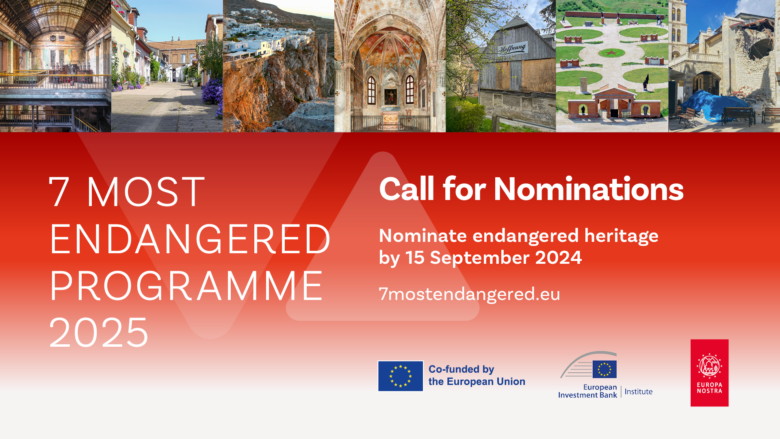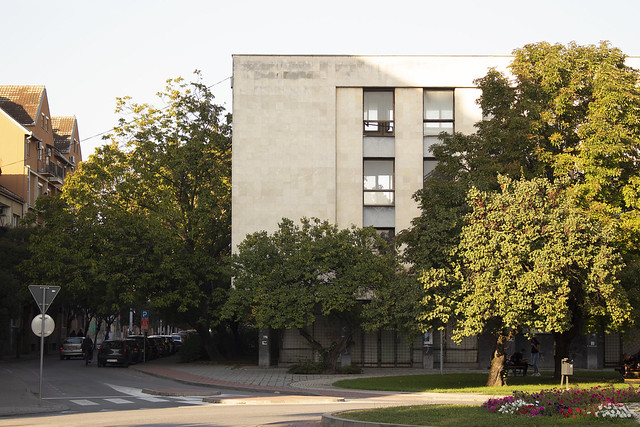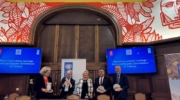Europa Nostra and EIB Institute announce Europe’s 7 Most Endangered Heritage Sites 2024
The list of the 7 Most Endangered monuments and heritage sites in Europe for 2024 was announced today by Europa Nostra, the European Voice of Civil Society Committed to Cultural and Natural Heritage, and the European Investment Bank Institute.
These are the 7 Most Endangered heritage sites in Europe for 2024:
Working-class Housing (courées) in Roubaix-Tourcoing, FRANCE
Cycladic Islands, notably Sifnos, Serifos and Folegandros, GREECE
Church of San Pietro in Gessate, Milan, ITALY
Synagogue of Siena, ITALY
Home of the Yugoslav People’s Army in Šabac, SERBIA
Greek Orthodox Church of St. Georgios, Altınözü / Hatay province, TÜRKIYE
Iron Gate of Antioch, Antakya / Hatay province, TÜRKIYE
The announcement was made at an online event featuring nominators and representatives of the selected sites, which attracted participants from across Europe and beyond.
This year’s list comprises two heritage sites in the Hatay province in Türkiye that were heavily damaged by the devastating earthquake of 6 February 2023, which caused severe human and heritage losses in the wider region, as well as a religious building in Siena in Italy that suffered structural damage as the result of an earthquake that occurred in the same month.
The Board of Europa Nostra selected the finalists from among the 11 monuments and heritage sites from nine countries previously shortlisted by the Advisory Panel of the 7 Most Endangered programme. The nominations of the sites for the 7 Most Endangered Programme 2024 were put forward by member organisations, associate organisations and individual members of Europa Nostra.
The selection of the 7 sites was made on the basis of the heritage significance and cultural value of each of the sites, as well as the serious danger that they are facing today. The level of engagement of local communities and the commitment of public and private stakeholders (including the corresponding nominator) to saving these sites were considered crucial added values. Another selection criterion was the potential of these sites to act as a catalyst for sustainable socio-economic development.

The 7 selected sites are eligible for an EIB Heritage Grant of €10,000 per site to assist in implementing an agreed early activity that will contribute to saving the threatened sites.
Teams of experts representing Europa Nostra and the European Investment Bank Institute, together with the organisations that nominated the 7 selected sites and other partners, will now gather information and meet with key stakeholders to assess the sites and issue a technical and financial report with recommendations for action.
The Executive Vice-President of Europa Nostra, Guy Clausse, stated: “The 2024 list of 7 Most Endangered comprises three heritage sites seriously damaged by natural disasters, as well as heritage sites threatened by demolition, unsuitable development, or lack of funding. Together with our partners (European and national), we will provide technical expertise, identify possible sources of funding, and mobilise our wide network to support the efforts of the local communities to save these sites. It is our common responsibility to preserve and enhance our shared heritage. Our heritage is instrumental in building a more sustainable, inclusive, and peaceful Europe.”
The Director and Head of the European Investment Bank Institute, Shiva Dustdar, said: “When disaster hit Türkiye and Syria, as well as Italy, last year, the EIB Group, through the Institute, was there to provide emergency relief and support. Now, with the 7 Most Endangered 2024, we will provide our expertise via both active and retired staff to three sites damaged by these catastrophes. This illustrates the win-win partnership between a vibrant civil society organisation and the EIB Group. It also helps shedding light on sites which could ultimately benefit from EIB Group advisory and financing support. We are proud to have recently renewed our partnership agreement with Europa Nostra through this flagship programme.”
From France to Turkey, preserving Europe’s shared heritage and identity
Being on the list of the 7 Most Endangered serves as a catalyst for action and as an incentive for mobilisation of the necessary public or private support. Ultimately, the listing helps raise awareness; it also fosters the sense of European identity and the feeling of belonging to a wider European community.
Working-class Housing (courées) in Roubaix-Tourcoing, FRANCE
In the 19th century, the cities of Roubaix and Tourcoing formed, together with the nearby city of Lille, the vibrant heart of France’s textile industry. These towns housed workers in a unique form of subsistence housing known as courées. Despite the poor living conditions, this architectural form persisted well into the 20th century. Only a handful remain, still inhabited and, to some extent, in good condition. However, the current municipal stance, favouring demolition within a new urban renovation plan, poses a significant threat.
Nominated by the Association Métropole Label.le
Cycladic Islands, notably Sifnos, Serifos and Folegandros, GREECE
Spreading across the Aegean Sea, the Cyclades archipelago comprises around 220 islands. The mountainous and rugged terrain of the islands contributes to their distinctive character. Another notable element of the Cycladic landscape is the presence of agricultural lands hosting small rural houses, windmills and farms. The Cyclades, in particular the smaller islands, are at risk of losing their authentic character as increasing tourist-oriented construction threatens to overshadow their inherent allure.
Nominated by Elliniki Etairia – Society for the Environment and Cultural Heritage with the support of the mayors of three especially affected islands: Serifos, Sifnos and Folegandros
Church of San Pietro in Gessate, Milan, ITALY
Situated in the heart of Milan, the Church of San Pietro was completed in the 15th century. The fresco cycles decorating the side chapels, made by Lombard painters and other renowned European artists, enrich the site with an important historical and artistic value. Although the roofs were repaired about 20 years ago, the site is rapidly deteriorating, with the consequent loss of portions of the 15th-century paintings. There is a lack of resources for the demanding works needed for its safeguard.
Nominated by an individual member of Europa Nostra from Italy with the support of the Pastoral Community “Holy Prophets” and the Superintendency of Archaeology, Fine Arts and Landscape for the city of Milan
Synagogue of Siena, ITALY
The Synagogue of Siena is one of the few examples in Europe of a pre-19th century synagogue that has not been destroyed and is still in use by the local community. Built in 1786 by the architect Giuseppe del Rosso, it showcases a blend of Rococo and Neoclassical elements. The building attracts thousands of tourists each year. The earthquake in February 2023 caused structural damage to the vault of the Synagogue of Siena. The restoration project of the synagogue got approval from the supervisory bodies but seeks further funding.
Nominated by an individual member of Europa Nostra from France with the Jewish Community of Florence and the World Monuments Fund Spain
Home of the Yugoslav People’s Army in Šabac, SERBIA
The Home of the Yugoslav People’s Army in Šabac was built in 1962, serving as a vibrant cultural and social hub. A survey underscored strong community interest in preserving this Modernist building. Urgent action is needed to convince city authorities to restore the building, preserving its historical and cultural significance. Without prompt restoration the roof terrace could be damaged due to exposure to weather conditions.
Nominated by Save the Home of the Yugoslav People’s Army
Greek Orthodox Church of St. Georgios, Altınözü / Hatay province, TÜRKIYE
Located in the Sarılar neighbourhood of Altınözü, the Greek Orthodox Church of St. Georgios has served as a gathering point and cultural centre for over a thousand years. The church’s Byzantine architecture is evident through the use of large cut stones and small stone keystones, traits attributed to the Crusader period. The devastating earthquake of 6 February 2023 has led to the collapse of parts of the building. Without corrective measures, further damage to the church’s roof and dome could increase the risk of the entire building collapsing.
Nominated by the Sarılar Neighbourhood Association and Europa Nostra Türkiye with the support of the Hatay Branch of Human Rights Associations
Iron Gate of Antioch, Antakya / Hatay province, TÜRKIYE
The Iron Gate of Antioch holds significant heritage value. Believed to be located close to where St. Peter gathered the first Christian community, this 18-metre-high stone structure is the only surviving gate of the originally five in the Antioch region. The damage to the gate due to the devastating earthquake of 6 February 2023 can be clearly observed. Even though there is no immediate risk of collapse and total loss of the monument, urgent action is needed to support and protect the structure from the effects of further deterioration.
Nominated by Europa Nostra Türkiye with the support of İskender Azaroğlu
7 Most Endangered Programme
The 7 Most Endangered Programme forms part of a civil society campaign to save Europe’s endangered heritage. This innovative programme mixes the vast cultural expertise and advocacy work of Europa Nostra with the technical appraisal and rescue planning skills of the EIB and its Institute.
Launched in 2013, the 7 Most Endangered Programme is run by Europa Nostra in partnership with the European Investment Bank Institute. It also has the support of the Creative Europe programme of the European Union through Europa Nostra’s network project European Cultural Heritage Agora.
Since the launch of the programme, 63 threatened monuments and heritage sites (from castles to bridges, factories and churches) from 31 countries across Europe have been selected. Some 25% of these projects have been successfully completed. Another 50% are making good or medium progress, and only three projects can be considered failures.
To mark the 10th anniversary of the 7 Most Endangered Programme in 2023, the EIB released the brochure ‘Saving the Past – Shaping the Future’, which highlights in particular some of the success stories and the importance of partnerships and community engagement. The brochure, produced in close collaboration with Europa Nostra, can be read in six languages (English, French, German, Italian, Spanish and Polish).
Find out more
Press releases All sites – English │ Courées in Roubaix-Tourcoing – French │ Cycladic Islands – Greek │ Church of San Pietro – Italian │ Synagogue of Siena – Italian │ Home of the YPA – Serbian │ Church of St. Georgios & Iron Gate of Antioch – Turkish
Photos & e-banners │ Video
www.7mostendangered.eu
http://institute.eib.org
Call for Nominations for the 7 Most Endangered Programme 2025 is open

If you know of important heritage in Europe that is endangered, nominate it for the 7 Most Endangered Programme 2025 and join us in our efforts to save our heritage! Both tangible and intangible heritage are eligible for the programme, regardless of whether it is publicly or privately owned.
You can submit a nomination for the programme with the support of a member or associate organisation of Europa Nostra or by becoming an individual member of Europa Nostra.
For more information and online submissions, please visit the 7 Most Endangered website.
Europa Nostra
Joana Pinheiro, Communications Advisor
jp@europanostra.org
M. +31 6 34 36 59 85
Europa Nostra
Antigoni Michael, 7 Most Endangered Programme Coordinator
am@europanostra.org
T. +31 (0) 70 302 40 51
European Investment Bank Institute
Bruno Rossignol, Head of Programme for Climate and Heritage
bruno.rossignol@eib.org
T. +352 43 797 07 67; M. +352 621345 862













